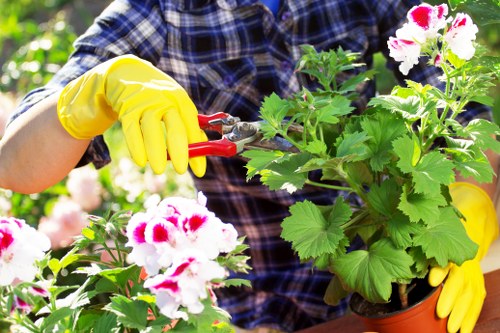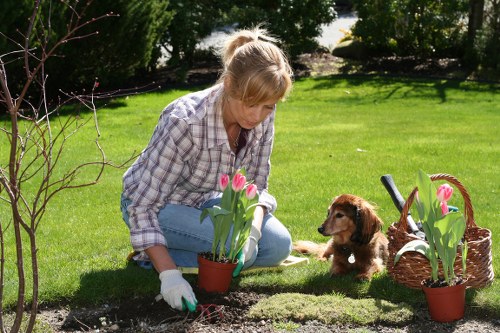Effective Driveway Algae Removal in Walthamstow Village

Maintaining a clean and safe driveway is essential for every homeowner in Walthamstow Village. One common issue that residents face is the growth of algae, which can make driveways slippery and unsightly. Understanding how to effectively remove algae not only enhances the appearance of your property but also ensures the safety of your family and visitors.
Algae thrives in moist, shaded environments, making driveways a perfect breeding ground, especially during the damp seasons. Factors such as poor drainage, lack of sunlight, and organic debris contribute to the rapid growth of algae. Addressing these underlying causes is crucial in preventing future algae infestations.
In this article, we will explore various methods and best practices for driveway algae removal in Walthamstow Village. From DIY solutions to professional services, you'll find comprehensive information to tackle this persistent problem effectively.

Understanding Algae Growth on Driveways
Algae are simple, plant-like organisms that absorb nutrients from their surroundings. On driveways, they often appear as green or black patches, making the surface slippery and increasing the risk of accidents. The presence of algae can also cause the degradation of driveway materials over time, leading to costly repairs or replacements.
Several factors contribute to algae growth, including:
- Moisture: Persistent dampness provides an ideal environment for algae to thrive.
- Shade: Areas with limited sunlight reduce the driveway's ability to dry quickly, promoting algae proliferation.
- Organic Matter: Leaves, dirt, and other debris can accumulate, offering nutrients for algae growth.
- Poor Drainage: Water pooling on the driveway surface creates stagnant conditions that favor algae development.
By addressing these factors, homeowners can significantly reduce the likelihood of algae taking hold on their driveways.

DIY Algae Removal Methods
For those who prefer a hands-on approach, several DIY methods can effectively remove algae from driveways. These solutions are often cost-effective and utilize readily available household items.
1. Pressure Washing
Using a pressure washer is one of the most efficient ways to eliminate algae. The high-pressure water stream removes built-up algae and stains, restoring the driveway's appearance. However, it's essential to use the appropriate pressure setting to avoid damaging the driveway surface.
2. Vinegar Solution
A natural and eco-friendly option involves mixing white vinegar with water. Apply the solution to the affected areas, allow it to sit for a few minutes, and then scrub with a stiff brush. Vinegar's acidity helps break down algae, making it easier to remove.
3. Baking Soda Paste
Creating a paste using baking soda and water provides another effective eradication method. Apply the paste to the algae-covered areas, let it sit for about 15 minutes, and then scrub clean. Baking soda not only removes algae but also deodorizes the driveway.
4. Bleach Mixture
A diluted bleach solution can be used for stubborn algae stains. Mix one part bleach with four parts water, apply it to the driveway, and allow it to sit for 10-15 minutes before scrubbing. It's crucial to rinse thoroughly after using bleach to prevent discoloration.
5. Commercial Algae Removers
There are numerous commercial products specifically designed for algae removal. These products often contain potent ingredients that quickly eliminate algae. Always follow the manufacturer's instructions for the best results.

Preventing Future Algae Growth
Once you've successfully removed algae from your driveway, taking preventive measures is vital to ensure it doesn't return. Implementing these strategies can help maintain a clean and safe driveway year-round.
1. Improve Drainage
Ensuring proper drainage prevents water from pooling on the driveway surface. Consider installing drainage systems or regrading the driveway to facilitate better water flow.
2. Increase Sunlight Exposure
Trim overhanging branches and remove any obstructions that block sunlight. More sunlight helps the driveway dry faster, creating an unfavorable environment for algae growth.
3. Regular Cleaning
Maintain a routine cleaning schedule to remove organic debris like leaves and dirt. Regular cleaning reduces the nutrients available for algae, inhibiting its growth.
4. Sealant Application
Applying a sealant to your driveway creates a protective barrier against moisture and contaminants. Sealants make it harder for algae to attach and thrive on the surface.
5. Use Algaecides
Periodic application of algaecides can help prevent algae spores from germinating. Choose environmentally friendly algaecides to minimize any adverse effects on surrounding vegetation.

Hiring Professional Algae Removal Services
While DIY methods are effective, some homeowners may prefer the expertise of professional services. Professional algae removal companies in Walthamstow Village offer comprehensive solutions tailored to your driveway's specific needs.
Benefits of Professional Services
- Expertise: Professionals have the knowledge and experience to handle various driveway materials and algae types.
- Advanced Equipment: They use specialized tools and eco-friendly products for thorough and safe algae removal.
- Time-Saving: Hiring experts frees up your time, allowing you to focus on other important tasks.
- Long-Term Solutions: Professionals provide recommendations and services to prevent future algae growth effectively.
When selecting a professional service, consider factors such as reputation, pricing, and the range of services offered. Reading reviews and asking for recommendations can help you choose a reliable provider in Walthamstow Village.
Choosing the Right Service Provider
Look for companies that offer comprehensive algae removal packages, including cleaning, sealing, and preventive treatments. Ensure they use environmentally friendly products to protect your driveway and the surrounding ecosystem. Comparing multiple providers can help you find the best fit for your needs and budget.
Local Relevance: Areas Surrounding Walthamstow Village
Walthamstow Village is surrounded by several neighborhoods and areas, each with its unique characteristics. Understanding the proximity and features of these nearby areas can be beneficial, especially when seeking local services for driveway algae removal.
- Blackstock Road: Just northwest of Walthamstow Village, Blackstock Road offers a variety of shops and eateries, making it a convenient location for residents seeking algae removal services nearby.
- Chingford: Located to the northeast, Chingford is known for its parks and green spaces, providing a scenic backdrop for homeowners requiring driveway maintenance.
- South Chingford: Adjacent to Chingford, South Chingford is a residential area with access to professional driveway cleaning services.
- St James Street: South of Walthamstow Village, St James Street is a bustling area with numerous local businesses that can assist with algae removal needs.
- Treasure House: Southeast of the village, Treasure House is a peaceful neighborhood where residents often seek eco-friendly algae removal solutions.
- Walthamstow Marshes: East of the village, Walthamstow Marshes offers natural beauty, and residents here prioritize environmentally safe algae removal methods.
- Whitehorse Lane: Located to the southwest, Whitehorse Lane is a suburban area with access to reliable driveway maintenance services.
- Bush Hill Park: Northwest of Walthamstow Village, Bush Hill Park is known for its residential tranquility, where homeowners prefer professional algae removal for longevity.
- Hayes Park: West of the village, Hayes Park provides a community-oriented atmosphere, with local services catering to driveway cleaning and maintenance.
- Birch Walk: Further south, Birch Walk is a growing area with an increasing demand for algae removal services due to newer driveway installations.
- Elm Park: Northeast of Walthamstow Village, Elm Park combines residential and commercial spaces, offering diverse options for driveway maintenance.
- Holloway Road: Adjacent to Walthamstow Village, Holloway Road is a major thoroughfare with easy access to various service providers specializing in algae removal.
- High Road: To the southeast, High Road is renowned for its vibrant community and availability of expert driveway cleaning services.
- Oak Street: Southwest of the village, Oak Street is a quiet area where residents often rely on trusted local professionals for algae removal.
- Palace Gardens: Nestled close to Walthamstow Village, Palace Gardens is a picturesque area that emphasizes the importance of maintaining clean and safe driveways.
Conclusion
Driveway algae can pose both aesthetic and safety concerns for homeowners in Walthamstow Village. By understanding the causes and implementing effective removal and prevention strategies, you can maintain a clean and secure driveway year-round.
Whether you choose to tackle the problem yourself using DIY methods or prefer the expertise of professional services, the key is to act promptly and consistently. Regular maintenance, combined with proactive measures, will ensure that your driveway remains algae-free and retains its value for years to come.
Frequently Asked Questions
- What are the best DIY methods for removing driveway algae?
Pressure washing, vinegar solutions, baking soda paste, bleach mixtures, and commercial algae removers are effective DIY methods for algae removal.
- How can I prevent algae from growing on my driveway?
Improve drainage, increase sunlight exposure, maintain regular cleaning, apply a sealant, and use algaecides to prevent future algae growth.
- When should I hire a professional for algae removal?
If DIY methods are ineffective, if the algae cover is extensive, or if you prefer expert handling, hiring a professional service is recommended.
- Are there eco-friendly solutions for algae removal?
Yes, solutions like vinegar, baking soda, and environmentally friendly algaecides are effective and eco-friendly options for algae removal.
- How often should I clean my driveway to prevent algae growth?
Regular cleaning every few months, especially after damp seasons, helps prevent algae from establishing and spreading.


